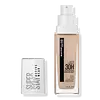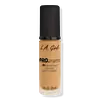What's inside
What's inside
 Key Ingredients
Key Ingredients

 Benefits
Benefits

 Concerns
Concerns

 Ingredients Side-by-side
Ingredients Side-by-side

Water
Skin ConditioningIsododecane
EmollientDimethicone
EmollientAcrylates/Polytrimethylsiloxymethacrylate Copolymer
Skin ConditioningCellulose
AbsorbentLauryl PEG-9 Polydimethylsiloxyethyl Dimethicone
Skin ConditioningVinyl Dimethicone/Methicone Silsesquioxane Crosspolymer
PEG-10 Dimethicone
Skin ConditioningMagnesium Sulfate
Phenoxyethanol
PreservativeDisteardimonium Hectorite
StabilisingSodium Hyaluronate
HumectantDimethicone/Polyglycerin-3 Crosspolymer
CleansingCetyl PEG/PPG-10/1 Dimethicone
EmulsifyingSilica Silylate
EmollientTriethoxycaprylylsilane
Propylene Carbonate
SolventCaprylyl Glycol
EmollientXanthan Gum
EmulsifyingTrisodium Ethylenediamine Disuccinate
Ethylhexylglycerin
Skin ConditioningAlumina
AbrasiveSilica
AbrasiveDipropylene Glycol
HumectantDisodium Stearoyl Glutamate
CleansingAluminum Hydroxide
EmollientTocopherol
AntioxidantPentaerythrityl Tetra-Di-T-Butyl Hydroxyhydrocinnamate
AntioxidantCI 77891
Cosmetic ColorantCI 77491
Cosmetic ColorantCI 77492
Cosmetic ColorantCI 77499
Cosmetic ColorantCI 77007
Cosmetic ColorantWater, Isododecane, Dimethicone, Acrylates/Polytrimethylsiloxymethacrylate Copolymer, Cellulose, Lauryl PEG-9 Polydimethylsiloxyethyl Dimethicone, Vinyl Dimethicone/Methicone Silsesquioxane Crosspolymer, PEG-10 Dimethicone, Magnesium Sulfate, Phenoxyethanol, Disteardimonium Hectorite, Sodium Hyaluronate, Dimethicone/Polyglycerin-3 Crosspolymer, Cetyl PEG/PPG-10/1 Dimethicone, Silica Silylate, Triethoxycaprylylsilane, Propylene Carbonate, Caprylyl Glycol, Xanthan Gum, Trisodium Ethylenediamine Disuccinate, Ethylhexylglycerin, Alumina, Silica, Dipropylene Glycol, Disodium Stearoyl Glutamate, Aluminum Hydroxide, Tocopherol, Pentaerythrityl Tetra-Di-T-Butyl Hydroxyhydrocinnamate, CI 77891, CI 77491, CI 77492, CI 77499, CI 77007
Water
Skin ConditioningDimethicone
EmollientCyclopentasiloxane
EmollientAluminum Starch Octenylsuccinate
AbsorbentGlycerin
HumectantMethyl Methacrylate Crosspolymer
Silica
AbrasivePEG-10 Dimethicone
Skin ConditioningPhenoxyethanol
PreservativeDimethicone/Vinyl Dimethicone Crosspolymer
Skin ConditioningDisteardimonium Hectorite
StabilisingCaprylyl Glycol
EmollientAlumina
AbrasiveEthylhexylglycerin
Skin ConditioningPanthenol
Skin ConditioningDisodium EDTA
Tocopheryl Acetate
AntioxidantHelianthus Annuus Seed Oil
EmollientTrimethoxycaprylylsilane
SmoothingTriethoxycaprylylsilane
Talc
AbrasiveParfum
MaskingButylphenyl Methylpropional
PerfumingLinalool
PerfumingHexyl Cinnamal
PerfumingTocopherol
AntioxidantIron Oxides
CI 77891
Cosmetic ColorantWater, Dimethicone, Cyclopentasiloxane, Aluminum Starch Octenylsuccinate, Glycerin, Methyl Methacrylate Crosspolymer, Silica, PEG-10 Dimethicone, Phenoxyethanol, Dimethicone/Vinyl Dimethicone Crosspolymer, Disteardimonium Hectorite, Caprylyl Glycol, Alumina, Ethylhexylglycerin, Panthenol, Disodium EDTA, Tocopheryl Acetate, Helianthus Annuus Seed Oil, Trimethoxycaprylylsilane, Triethoxycaprylylsilane, Talc, Parfum, Butylphenyl Methylpropional, Linalool, Hexyl Cinnamal, Tocopherol, Iron Oxides, CI 77891
 Reviews
Reviews

Ingredients Explained
These ingredients are found in both products.
Ingredients higher up in an ingredient list are typically present in a larger amount.
Alumina is another name for the compound aluminum oxide. It is used as a thickener, absorbent, and abrasive.
As an absorbent, alumina can give a mattifying effect. It is used in mineral sunscreens to help coat nano-sized filters, such as titanium dioxide. By increasing the size of the UV filters, these ingredients stay on the skin for a longer time. By coating small sized ingredients, alumina helps thicken a product.
Alumina may be used as an abrasive, or exfoliant.
Alumina is naturally occurring in the mineral corundum. Certain varieties of corundum create rubies and sapphires. Corundum is also the crystalline form of alumina.
Learn more about AluminaCaprylyl Glycol is a humectant and emollient, meaning it attracts and preserves moisture.
It is a common ingredient in many products, especially those designed to hydrate skin. The primary benefits are retaining moisture, skin softening, and promoting a healthy skin barrier.
Though Caprylyl Glycol is an alcohol derived from fatty acids, it is not the kind that can dry out skin.
This ingredient is also used as a preservative to extend the life of products. It has slight antimicrobial properties.
Learn more about Caprylyl GlycolCi 77891 is a white pigment from Titanium dioxide. It is naturally found in minerals such as rutile and ilmenite.
It's main function is to add a white color to cosmetics. It can also be mixed with other colors to create different shades.
Ci 77891 is commonly found in sunscreens due to its ability to block UV rays.
Learn more about CI 77891Dimethicone is a type of synthetic silicone created from natural materials such as quartz.
What it does:
Dimethicone comes in different viscosities:
Depending on the viscosity, dimethicone has different properties.
Ingredients lists don't always show which type is used, so we recommend reaching out to the brand if you have questions about the viscosity.
This ingredient is unlikely to cause irritation because it does not get absorbed into skin. However, people with silicone allergies should be careful about using this ingredient.
Note: Dimethicone may contribute to pilling. This is because it is not oil or water soluble, so pilling may occur when layered with products. When mixed with heavy oils in a formula, the outcome is also quite greasy.
Learn more about DimethiconeDisteardimonium Hectorite comes from the clay mineral named hectorite. It is used to add thickness to a product.
It can also help stabilize a product by helping to disperse other ingredients.
Hectorite is a rare, white clay mineral.
Learn more about Disteardimonium HectoriteEthylhexylglycerin (we can't pronounce this either) is commonly used as a preservative and skin softener. It is derived from glyceryl.
You might see Ethylhexylglycerin often paired with other preservatives such as phenoxyethanol. Ethylhexylglycerin has been found to increase the effectiveness of these other preservatives.
Peg-10 Dimethicone is silicone with conditioner and emulsifier properties. It mostly acts as an emollient in skincare and and humectant in haircare.
According to the manufacturer, acidic formulations decrease the stability of this ingredient. It works best in neutral or near neutral formulations.
Phenoxyethanol is a preservative that has germicide, antimicrobial, and aromatic properties. Studies show that phenoxyethanol can prevent microbial growth. By itself, it has a scent that is similar to that of a rose.
It's often used in formulations along with Caprylyl Glycol to preserve the shelf life of products.
Silica, also known as silicon dioxide, is a naturally occurring mineral. It is used as a fine, spherical, and porous powder in cosmetics.
Though it has exfoliant properties, the function of silica varies depending on the product.
The unique structure of silica enhances the spreadability and adds smoothness, making it a great texture enhancer.
It is also used as an active carrier, emulsifier, and mattifier due to its ability to absorb excess oil.
In some products, tiny microneedles called spicules are made from silica or hydrolyzed sponge. When you rub them in, they lightly polish away dead skin layers and enhance the penetration of active ingredients.
Learn more about SilicaTocopherol (also known as Vitamin E) is a common antioxidant used to help protect the skin from free-radicals and strengthen the skin barrier. It's also fat soluble - this means our skin is great at absorbing it.
Vitamin E also helps keep your natural skin lipids healthy. Your lipid skin barrier naturally consists of lipids, ceramides, and fatty acids. Vitamin E offers extra protection for your skin’s lipid barrier, keeping your skin healthy and nourished.
Another benefit is a bit of UV protection. Vitamin E helps reduce the damage caused by UVB rays. (It should not replace your sunscreen). Combining it with Vitamin C can decrease sunburned cells and hyperpigmentation after UV exposure.
You might have noticed Vitamin E + C often paired together. This is because it is great at stabilizing Vitamin C. Using the two together helps increase the effectiveness of both ingredients.
There are often claims that Vitamin E can reduce/prevent scarring, but these claims haven't been confirmed by scientific research.
Learn more about TocopherolTriethoxycaprylylsilane is a silicone used to bind and stabilize ingredients.
As an emulsifier, it helps prevent ingredients from separating. This can help elongate the shelf life of products.
Triethoxycaprylylsilane is often used to coat mineral sunscreens ingredients to help give a better feel. It also helps reduce oxidative stress in sunscreens.
Learn more about TriethoxycaprylylsilaneWater. It's the most common cosmetic ingredient of all. You'll usually see it at the top of ingredient lists, meaning that it makes up the largest part of the product.
So why is it so popular? Water most often acts as a solvent - this means that it helps dissolve other ingredients into the formulation.
You'll also recognize water as that liquid we all need to stay alive. If you see this, drink a glass of water. Stay hydrated!
Learn more about Water